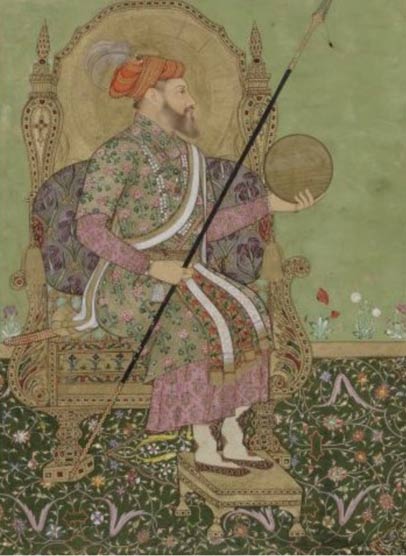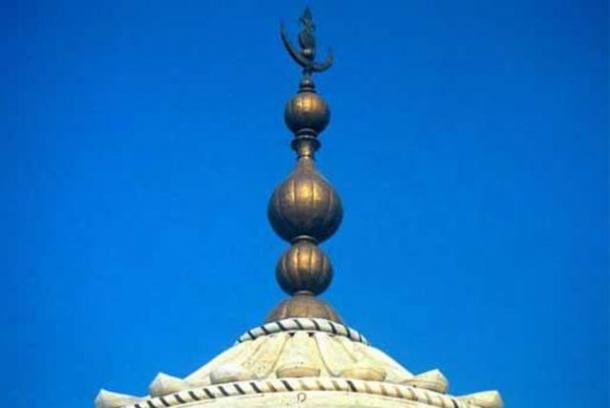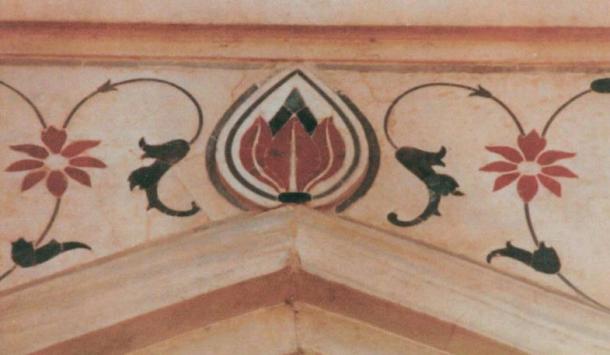Anyone who has visited the Taj Mahal would have been told the endearing love story behind its construction – 17th century Mughal Emperor, Shah Jahan, was heartbroken following the death of his favorite wife during childbirth so he brought the most skilled craftsmen from across Asia and Europe to build the white mausoleum that is known today as the Taj Mahal. However, the story has been challenged by some academics, and now a government minister, who claim the world has been duped and that rather than an Islamic mausoleum, the Taj Mahal is actually part of an ancient Hindu temple palace of Lord Shiva, known as the Tejo Mahalaya.
According to Professor P.N. Oak, author of Taj Mahal: The True Story, the ancient Shiva temple palace was usurped by Shah Jahan from the then Maharaja of Jaipur, Jai Singh. Shah Jahan then remodelled the palace into his wife’s memorial.

According to conventional accounts, the Taj Mahal was commissioned by Mughal Emperor Shah Jahan (pictured). (Wikipedia)
“When told that you are visiting a temple palace [rather than a tomb] you won’t fail to notice its annexes, ruined defensive walls, hillocks, moats, cascades, fountains, majestic garden, hundreds of rooms arched verandas, terraces, multi-stored towers, secret sealed chambers, guest rooms, stables, the trident (Trishul) pinnacle on the dome and the sacred, esoteric Hindu letter "OM" carved on the exterior of the wall of the sanctum sanctorum now occupied by the cenotaphs,” writes Professor Oak in his article ‘The Tajmahal is Tejomahalay, A Hindu Temple’.

The pinnacle of the Taj Mahal, depicting the Hindu horizontal crescent, coconut, bent mango leaves, and supporting Kalash (water pot), all exclusive Hindu motifs. (taj-mahal.net)
According to ‘The Controversy Surrounding the Origins of the Taj Mahjal’ on the BBC, “The use of captured temples and mansions as a burial place for dead courtiers and royalty was a common practice among Muslim rulers. For example, Hamayun, Akbar, Etmud-ud-Daula and Safdarjung are all buried in such mansions.”
A Bharatiya Janata Party Minister, Laxmikant Bajpai, has now refuelled the debate behind the origins of the Taj Mahal by publicly announcing that the Taj Mahal was indeed part of an ancient Hindu temple and that the documents that prove it still exist. The Times of India reports that his comments were made in response to attempts to hand over the Taj Mahal to the Uttar Ptradesh Sunni & Shia Waqf Board, an Indian statutory body that works under the context of 'sadaqah', a religious endowment in Islamic law, typically donating a building or plot of land for Muslim religious or charitable purposes.

Lotus flower, a Hindu symbol, at the apex of a doorway in the Taj Mahal.
Professor Oak has provided numerous pieces of evidence to support the view that the Taj Mahal was originally a Hindu Temple. For a start, the name of Shah Jahan’s wife that died in childbirth was never ‘Mumtaz Mahal’ but ‘Mumtaz-ul-Zamani’ and the name ‘Mahal’ has never been used for a building in any Muslim country. The name Taj Mahal, he claims, is a corrupt version of Tejo Mahalaya (Shiva’s Palace). He also refers to the fact that there is not a single royal chronicle from Shah Jahan’s era that corroborates the so-called love story.
The BBC writes that Professor Oak refers to a number of documents that suggest that the Taj Mahal predates Shah Jahan's era:
Professor Marvin Miller of New York took samples from the riverside doorway of the Taj. Carbon dating tests revealed that the door was 300 years older than Shah Jahan.
European traveller Johan Albert Mandelslo, who visited Agra in 1638 (only seven years after Mumtaz's death), describes the life of the city in his memoirs, but makes no reference to the Taj Mahal being built.
The writings of Peter Mundy, an English visitor to Agra within a year of Mumtaz's death, also suggest that the Taj was a noteworthy building long well before Shah Jahan's time.
Numerous pieces of photographic evidence linking the Taj Mahal to a Hindu temple is also available in the article ‘Was the Taj Mahal a Vedic Temple?’.
Oak claims that within the many sealed rooms of the Taj Mahal, there are statues of Shiva and other objects of veneration relating to the Hindu faith. One way to validate or discredit Oak's research, would be to open up this sealed rooms for international experts to investigate.
According to Professor P.N. Oak, author of Taj Mahal: The True Story, the ancient Shiva temple palace was usurped by Shah Jahan from the then Maharaja of Jaipur, Jai Singh. Shah Jahan then remodelled the palace into his wife’s memorial.

According to conventional accounts, the Taj Mahal was commissioned by Mughal Emperor Shah Jahan (pictured). (Wikipedia)
“When told that you are visiting a temple palace [rather than a tomb] you won’t fail to notice its annexes, ruined defensive walls, hillocks, moats, cascades, fountains, majestic garden, hundreds of rooms arched verandas, terraces, multi-stored towers, secret sealed chambers, guest rooms, stables, the trident (Trishul) pinnacle on the dome and the sacred, esoteric Hindu letter "OM" carved on the exterior of the wall of the sanctum sanctorum now occupied by the cenotaphs,” writes Professor Oak in his article ‘The Tajmahal is Tejomahalay, A Hindu Temple’.

The pinnacle of the Taj Mahal, depicting the Hindu horizontal crescent, coconut, bent mango leaves, and supporting Kalash (water pot), all exclusive Hindu motifs. (taj-mahal.net)
According to ‘The Controversy Surrounding the Origins of the Taj Mahjal’ on the BBC, “The use of captured temples and mansions as a burial place for dead courtiers and royalty was a common practice among Muslim rulers. For example, Hamayun, Akbar, Etmud-ud-Daula and Safdarjung are all buried in such mansions.”
A Bharatiya Janata Party Minister, Laxmikant Bajpai, has now refuelled the debate behind the origins of the Taj Mahal by publicly announcing that the Taj Mahal was indeed part of an ancient Hindu temple and that the documents that prove it still exist. The Times of India reports that his comments were made in response to attempts to hand over the Taj Mahal to the Uttar Ptradesh Sunni & Shia Waqf Board, an Indian statutory body that works under the context of 'sadaqah', a religious endowment in Islamic law, typically donating a building or plot of land for Muslim religious or charitable purposes.

Lotus flower, a Hindu symbol, at the apex of a doorway in the Taj Mahal.
Professor Oak has provided numerous pieces of evidence to support the view that the Taj Mahal was originally a Hindu Temple. For a start, the name of Shah Jahan’s wife that died in childbirth was never ‘Mumtaz Mahal’ but ‘Mumtaz-ul-Zamani’ and the name ‘Mahal’ has never been used for a building in any Muslim country. The name Taj Mahal, he claims, is a corrupt version of Tejo Mahalaya (Shiva’s Palace). He also refers to the fact that there is not a single royal chronicle from Shah Jahan’s era that corroborates the so-called love story.
The BBC writes that Professor Oak refers to a number of documents that suggest that the Taj Mahal predates Shah Jahan's era:
Professor Marvin Miller of New York took samples from the riverside doorway of the Taj. Carbon dating tests revealed that the door was 300 years older than Shah Jahan.
European traveller Johan Albert Mandelslo, who visited Agra in 1638 (only seven years after Mumtaz's death), describes the life of the city in his memoirs, but makes no reference to the Taj Mahal being built.
The writings of Peter Mundy, an English visitor to Agra within a year of Mumtaz's death, also suggest that the Taj was a noteworthy building long well before Shah Jahan's time.
Numerous pieces of photographic evidence linking the Taj Mahal to a Hindu temple is also available in the article ‘Was the Taj Mahal a Vedic Temple?’.
Oak claims that within the many sealed rooms of the Taj Mahal, there are statues of Shiva and other objects of veneration relating to the Hindu faith. One way to validate or discredit Oak's research, would be to open up this sealed rooms for international experts to investigate.
- fonte: @edisonmariotti #edisonmariotti : http://www.ancient-origins.net/news-general/controversy-india-minister-says-taj-mahal-part-ancient-hindu-temple-002426#sthash.4bsxKfcW.dpuf


Nenhum comentário:
Postar um comentário